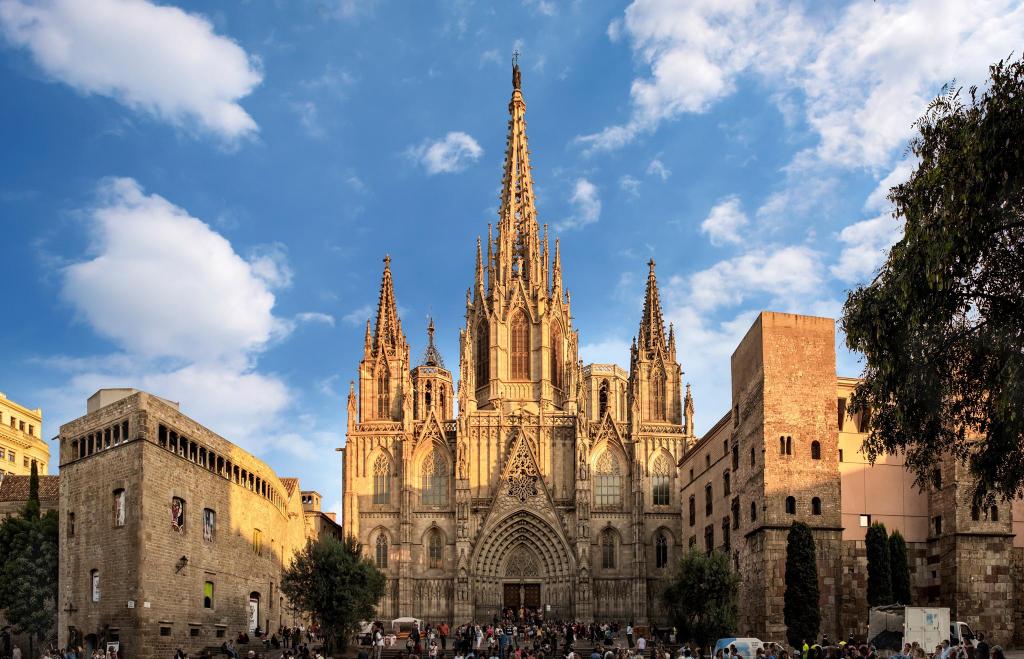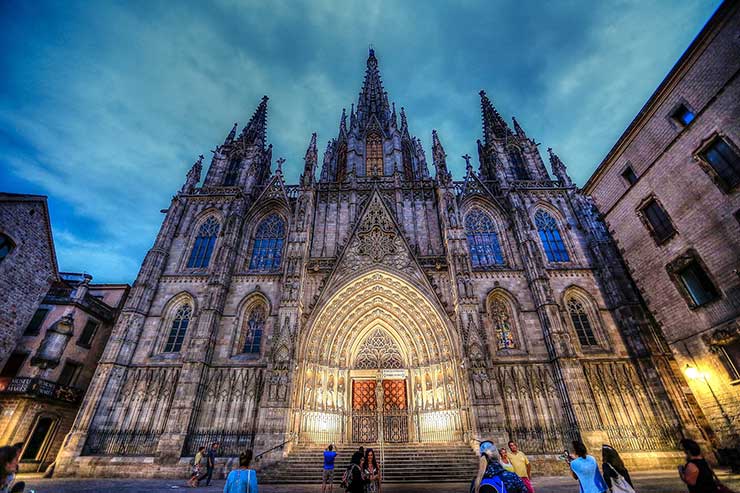The Barri Gotic in Barcelona is replete with a timeless allure that recalls a bygone era. In this pedestrian-only medieval neighbourhood, time seems to have stopped in its tracks, as buildings continue to look as they did centuries ago.
Tiny pedestrian alleyways reveal the wear and tear on their smoothed-down cobblestones, but imposing Gothic structures with stunning façades have survived the test of time. It's impossible to exhaust the area's secrets, which can be found anywhere from tucked-away arcaded passageways to welcoming patios with quiet fountains.
The classical Spanish guitar tunes of the street performers are best heard in the peaceful courtyards. Children sometimes utilize the empty plazas for spontaneous football games, and many of the little squares in the Gothic Quarter are home to charming outdoor cafés.
Catedral de Barcelona
This magnificent Gothic cathedral sits on the highest point of the Gothic Quarter, surrounded by charming ancient alleyways. The cathedral's foundations were laid in the Romanesque era and completed in the Middle Ages, and its exterior was refurbished in the late 19th and early 20th centuries.
Take in the magnificent facade, with an arched entryway and a plethora of spires and vertical buttresses. Enter this uplifting haven and let the light and open space fill you with new ideas.

Placa del Rei
One of the most picturesque plazas in the historic district of Barcelona is the Plaça del Rei. Its southern side provides access to the neighbourhood's winding alleyways and is flanked by magnificent medieval structures.
The Gothic Quarter's Palau Reial Major, located on Plaça del Rei, is a prime example of a medieval urban palace. When digging for the new palace's base, archaeologists uncovered significant artefacts below from the ancient Roman town.
The Casa Clariana Padellás, a palace from the 16th century that now houses the Museu Historia de la Ciutat and is accessible Tuesday through Sunday, may be found in another part of the square. The archaeological dig may be found in the museum's basement.
Cappella di Santa Agata
This Gothic church served as the Royal Palace chapel back when it was constructed in the 14th century on the location of the old Roman town wall. The Altare del Connestabile, painted by Jaume Huguet and housed in the church, is widely regarded as one of the most outstanding examples of Catalan art.
The different coats of arms of the counts of Barcelona are shown in stained glass windows in the choir and gallery. There's a beautiful iron mechanical clock from 1576 in the sacristy.
The tower of Martin el Humano, built in the 17th century, may be accessed through a tiny door in the church. While no longer a place of worship, the chapel's memorial is open to the public.

Museu Picasso
The Picasso Museum is housed among three historic palaces constructed in Catalan Gothic architecture between the 13th and 15th centuries on one of the most picturesque alleys in the Gothic Quarter.
The museum has an impressive array of artworks spanning all of Picasso's creative careers, including paintings, sketches, and prints. The exhibits trace Picasso's artistic evolution from early to late throughout his career.
The museum has the most important collection of Picasso's early works worldwide. Among Picasso's early works, Hombre con Boina, Paisaje Montaoso, and Retrato de la Madre del Artista stand out.
Iglesia de Santa Maria del Mar
The Iglesia de Santa Maria del Mar, a beautiful Catalan Gothic church built in the 14th century, is close to the Picasso Museum. This church is second only to the city's cathedral as the most important place of worship in the metropolis.
The beautiful rose window and main gateway are only two of the many decorative touches on the front. The magnificent sanctuary, though, is the main draw. The high-vaulted nave creates an atmosphere of tranquillity and openness with its towering columns. Above the rows of vaulted arches, several stained-glass windows flood the room with light.
Basílica of Santa Maria del Pí
The Gothic Santa Maria del P Basilica is a stunning example of a fortress-like church. A vast rose window and a Madonna statue in a pointed archway are the sole decorative features of the building's façade.
The primary, one-aisle interior is adorned with chapels on either side and stained glass windows dating from the 15th to the 18th century. Arnau Ferre's grave, which perished during the Sicilian Siege of Catania in the 14th century, may be found next to the sacristy's entrance.
Daily Mass is said at the Basilica of Santa Maria del P. The basilica welcomes visitors on Fridays and Saturdays for self-guided exploration and organized group tours.

Juliana Daniel Jan 03, 2023
Things To Do And See In Atlantic City, New Jersey

Juliana Daniel Aug 28, 2023
China Travel Guide

Juliana Daniel Dec 26, 2022
Everything You Need to Know About Boston's Historic Beacon

Sean William Aug 27, 2023
5 The Best Family-Friendly Safaris In South Africa

Sean William Dec 25, 2022
Ecotourism Will Help You Explore Karpathos

Sean William Aug 27, 2023
Get To Know About Top 10 Incredible Roman Ruins: An Overview

Sean William Jan 03, 2023
7 Suggestions For Visiting Asheville, Nc, From A Local

Sean William Aug 28, 2023